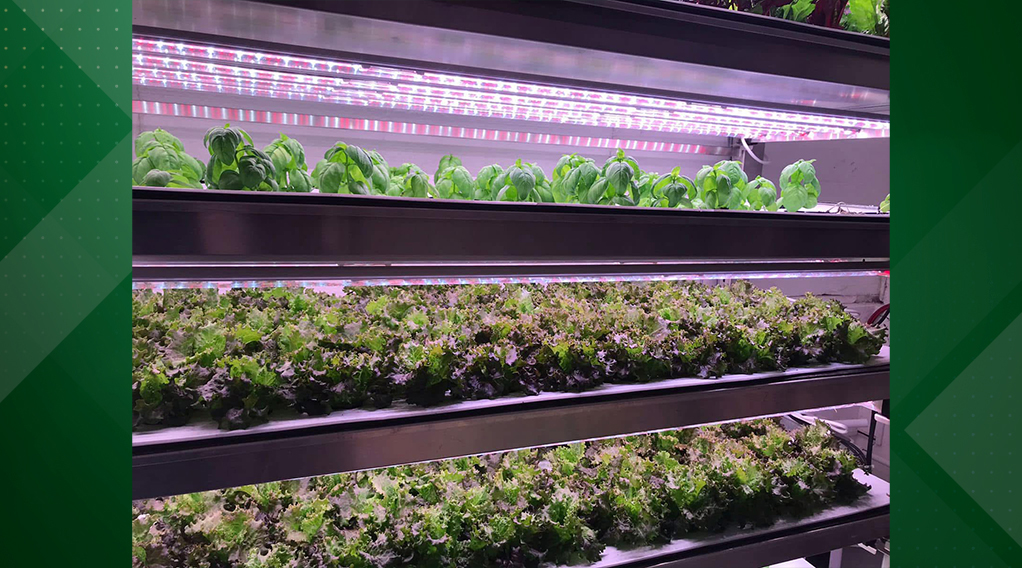Growing to New Heights: CSM Offers New Vertical Agriculture Course

The world’s population continues to grow, beyond 8 billion people, and every one of them needs to eat every day. How do farmers keep up with the demand when there is only so much fertile agricultural land to work from?
Thanks to a recently awarded $490,000 grant from the Tri-County Council for Southern Maryland to the College of Southern Maryland (CSM), students are learning that the answer could be to grow crops up instead of out – and vertically instead of horizontally.
CSM used the grant to purchase a 10-rack agricultural system from Karma Verde Fresh in Mexico and began courses in Fall 2024. The course’s first students learned the basics about plant health and growing. This semester students will use the vertical grow racks to grow plants, and a third course in the springtime will also have students heading out into local farms to put the technology to the test.
There are no costs to the current students, as tuition is also covered by the grant.
It took about a year to get the sustainable agriculture course set up and now the lab is up and running in the facilities management building at CSM’s La Plata Campus, said Jordan Jones-Cordero, course instructor.
“It’s been a long journey, but I’m really happy to be in the place where we are now,” she said.
Growing crops vertically can produce 10 to 20 times more vegetables than using traditional farming methods, she said. “It’s a large puzzle piece to help solve the problem of global food access. It really is a growing industry.” Vertical growing “extends the growing season, improving food access,” she said.
There are several advantages in using vertical growing techniques, Jones-Cordero explained. Plants don’t need soil in the racks. The seeds sit in medium in trays with water in them. The plant roots reach down to the water level for nourishment as the water is also mixed with plant nutrients. The water is then recycled so the operation uses about 95% less water than traditional growing methods.
Artificial lights that operate on a timer above each rack provide photosynthesis for the plants, and small fans provide the plants with aeration, Jones-Cordero further explained. And because the grow operation is indoors, plants are grown without the use of pesticides.
“We can control every aspect of the plants’ life,” Jones-Cordero said. “This field of study can also take you places globally. You can grow food in places you never thought possible. You can grow food in the middle of the desert.”
Both commercial farmers and hobbyists at home can use a vertical growing system, she said. The startup costs depend on the individual. A person can purchase a pre-made system, or they can make it themselves.
“This is so new, the possibilities are endless,” she explained. “You can do this as a hobby or a job. It just depends on what you want to do.”
“It’s an amazing experience. I’m excited,” student, CSM alumna, and Executive Director for the Center for Career Development and Success Dr. Larisa Pfeiffer said. She said with the information she received from the course that she would like to work with the disenfranchised to help sustain themselves with healthy and nutritious foods. “It might be a way to give back to humanity one day,” she said.
The plants grown in the CSM lab will be donated to CSM’s Hawk Pantry “so we can put it directly back into the community,” Jones-Cordero added. The CSM Hawk Pantry provides canned and packaged food at four of its campuses for students experiencing food insecurity.
“If someone is interested, I would say please come. There’s a little bit of everything in agriculture. I don’t think it would be a dull day if you chose to go into agriculture,” Jones-Cordero said.
Student Aubrey Zeltwanger recently graduated from CSM in environmental studies. She said this course was the next logical step as she pursues a career in sustainable agriculture.
“I believe vertical agriculture can solve some food insecurity issues,” said student Rachel Norris-Achterberg, who works at an educational farm in southern Calvert County. She said she would like to share this new technology with other farmers and those growing food for their own home.
The next vertical agriculture course opens to new students in June. To learn more, visit https://csmd.augusoft.net/index.cfm?method=ClassListing.ClassListingDisplay&int_category_id=35&int_sub_category_id=159&int_catalog_id=
 my.CSMD
my.CSMD